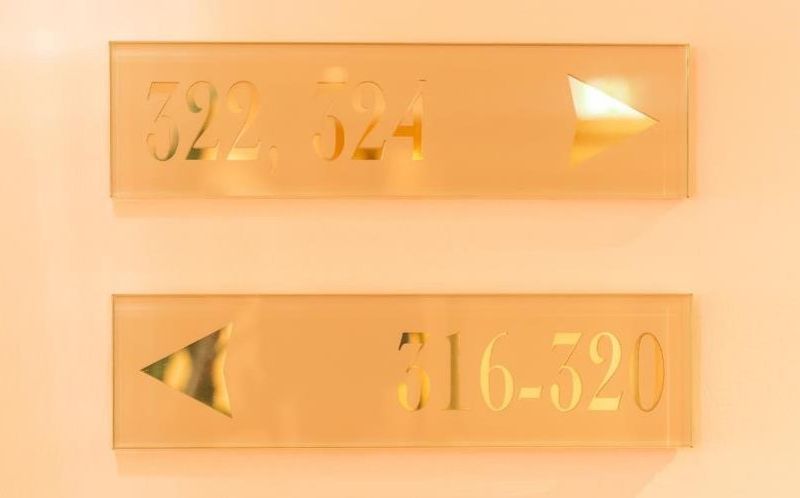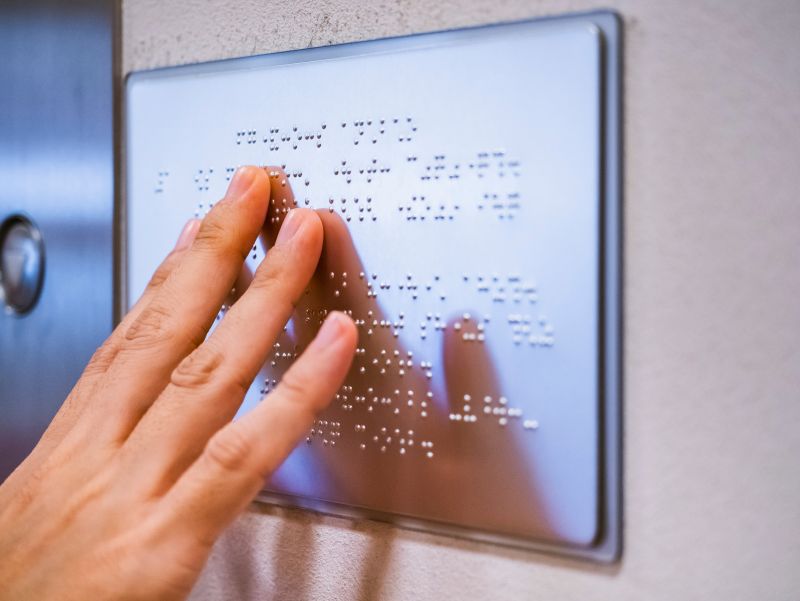Accessible signs, which also provide orientation assistance for blind and visually impaired people, conquer public spaces.
So it is not so easy to find the right solution. You will find an overview in this article:
Strong contrasts, large lettering and non-reflective material make a sign easier to read, even from a greater distance.
This is comfortable for all people and should therefore always be incorporated into sign design. After all, universal design is simply customer friendly!
However, even such signage are not truly accessible signs. This is because severely visually impaired and blind people still cannot access the information presented in this way.

Chic design, but little function. Because no one can read these signs well! Photo rights: @Martin Raffeiner
Tactile, or tactual, signs can be “read” with the hands and are especially suitable for visually impaired and blind people.
Braille is a tactile embossed script of dots. There are minimum dimensions for the size and spacing of the dots. Therefore, accessible signs with Braille need an appropriate size. And, of course, they must be in a position, where they can be easily reached with the hands. Ideally at eye level, because this corresponds to the DIN standard (130 – 160cm).
However, only very few people can read Braille. Of all blind people, only 20 – 25% are able to do so. For those, who go blind in old age, hardly manage to learn Braille. So here it needs a second solution!
Pyramid writing uses normal characters, but raised, so that they are both tactile and legible for sighted people. The pyramid script has slightly rounded upper edges and is executed sans serif in as even a stroke width as possible. Only capital letters are used almost exclusively. Here, too, the relevant DIN standard needs consideration.
There are also minimum sizes for tactile pictograms. But only use very simple pictograms, such as WC Men/Ladies.

Braille is unfortunately a solution for only very few people.
Here, data codes that provide an audio file make the texts of conventional signs accessible.
Audio format has the great advantage that it is suitable for all people who, for whatever reason, can not read. Because of age, visual impairment, blindness, cognitive impairment, (functional) illiteracy, reading disability or language deficit.
Audio Format can remove all these barriers.
Expensive studio recordings are no longer necessary for this. Thanks to new technologies such as voice assistants and text-to-speech, talking accessible signs are now even cheaper to produce than most tactile solutions.
A QR code on the sign calls up the text in a corresponding database and plays it back online as an audio stream on the user’s own smartphone.
The big downside to this is that it requires internet access. This means it doesn’t work always and everywhere. Therefore, Internet-based solutions are often impossible, e.g. for signposting hiking and nature trails.
Waiting for the connection, data transfer fees and privacy-related concerns are other disadvantages of QR codes.
This colored data code can “speak” and works without the Internet, because the code itself contains all the text.
Plus, it fulfills the 2-senses principle: Text AND speech, information to read AND hear.
After scanning, the free speechcode app (in universal design) shows the text on the display. And reads it out at the same time via voice assistant.
Accessible signs with NFC (Near Field Communication) tag are the most customer-friendly of all audio solutions:
No slow tactile reading, no special software, no internet, no optical scan.
Just touch the NFC Speech Tag with your own smartphone. Immediately, the text is transmitted without an Internet connection and read aloud by the speechcode app. It’s easy, fast and guaranteed free!
NFC Speech Tags require neither power nor network and are weatherproof and maintenance-free.
Furthermore, an NFC Speech Tag can hold lots of additional information if needed, up to 6 pages of A4. This means that accessible signs can contain helpful additional information for visually impaired and blind people.
Or even become audio guides for tourists.
Find out, why smart guidance systems can do more than just point the way:
read moreUsability is key for success. Therefore Universal design makes sense. Find 10 examples for best usability here
read moreFind out why Universal Design is not just about accessibility, but rather about good usability
read moreNow visitor information must work contactless. How to use your existing signage as low-cost Audio Guide. Do it now and…
read moreWhy accessible information in text AND speech can increase the reach of your message by up to 50 %.
read moreFind out how SpeechCode works: 5 steps to your personal SpeechCode - try it now!
read moreRead the latest SpeechCode blogs and news on the topics Universal Design, Customer Focus and Digitalisation.
read more